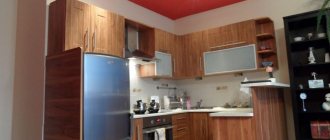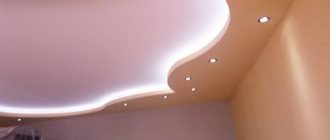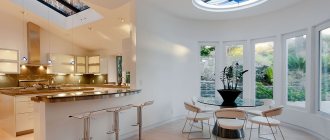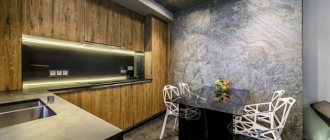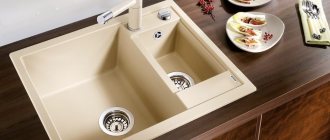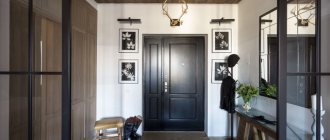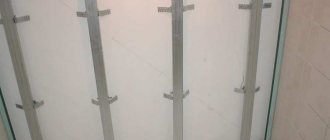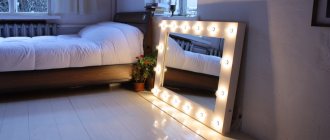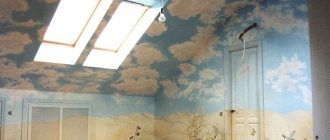The ideal wife is always the unconditional mistress of the kitchen, if you create suitable conditions for her and fill the space with comfort. Finishing the ceiling surface is one of the main touches on the way to this. The choice of materials is truly great, but numerous photos convince us that the ceiling in the kitchen made of plasterboard looks no worse than popular stretch fabrics, and in some ways even surpasses them. Read more about this with numerous photo examples of the best design options below.
The finishing of the ceiling surface of gypsum boards has become rapidly widespread along with the introduction of numerous options for additional lighting in the room. Specialists have successfully mastered this magical, in some cases, zoning tool and generously shared fresh ideas with numerous clients. The requirements of the kitchen space for the material placed on the ceiling matched perfectly with the characteristics of plasterboard - and beautiful design projects, full of interesting compositions and ideas, began to be actively implemented.
Features and Benefits
Plasterboard ceilings will help create a cozy design and atmosphere in the kitchen using different decorative finishes. This material is attractive in price, easy to install and can withstand heavy loads, and the moisture-resistant appearance of this material is perfect for the kitchen space.
Using drywall, you can create a multi-level design and install spotlights or hide unnecessary communications under its niche.
Finishing
After installation is complete, leave the structure for a couple of days, and then inspect it in bright light. If there are roughness and unevenness, go over them with fine sandpaper and clean the surface from dust with a dry brush.
To make the ceiling smooth as ice, the joints and screw heads must be sealed with putty.
To prevent cracks between the slabs, you can insert reinforcing tape. The putty is applied in several layers: each next one only after the previous one has completely dried. When the mixture dries, the seams must be treated with sandpaper.
Decorating such a ceiling is a pleasure. It is first coated with water-based paint, which is then supplemented with acrylic. You need to paint with a wide roller in at least two layers. Blue, green, and brown paints are saturated, so they immediately cover the surface tightly. And if orange, blue or olive paint is applied in one layer, a white surface may be visible in daylight.
Wallpaper sticks well to drywall and can also be used for ceiling decoration.
To create the perfect kitchen ceiling, use plasterboard sheets. There is no need to level the concrete ceiling and think about how to beautifully and discreetly route the wires - just install a structure made of metal and plasterboard, behind which all the shortcomings of the original ceiling will be hidden.
Registration requirements
For small rooms, spot lighting with low light is suitable: from faded to shining. The colors are muted or pastel tones.
If you still decide to use bright colors, then you should not choose acidic colors, because they can have a negative impact on the mood of household members.
Color scheme, drawings, stucco molding
Since we are talking about the design of the kitchen space, light or, if desired, bright colors will be preferable. It is necessary to remember the effect of color on appetite. Blue, violet, cyan - reduce appetite; red, yellow, orange - increase.
If you decide to make a modern ceiling with a pattern, or even with a 3D image, we will tell you about the most appropriate and popular pictures for the kitchen space. How to make a choice? What's suitable? We suggest: the most popular are photos of fruits and berries, images of a blue sky with airy clouds, plant motifs - images of flowers or leaves. The photo printing possibilities are endless; you can take any photo, even your own portrait!
Curly ceilings with 3D patterns look very beautiful, pay attention to such options, you may want to keep up with world fashion, because it is now gaining popularity.
If you have a kitchen in a classic style and you want to decorate the room with stucco, this will be appropriate when using a figured ceiling. Patterned stucco can be located near the lamp or along the periphery, to suit your taste.
Single-level plasterboard ceiling in the kitchen
When using high-quality material, this method is considered the most economical option. Since it is not difficult to install, you can install a plasterboard suspended ceiling in the kitchen yourself.
The finished ceiling covering can be decorated using plaster or paint, while maintaining its traditional appearance.
You can install inconvenient communications into it: electrics, ventilation, parts of the water supply system or lighting. It is possible to zone individual parts of the kitchen using different colors and textures.
For example, the work area can be done in more saturated colors, and the dining area can be made lighter. This will help separate the zones and provide a more comfortable, relaxing environment in the dining area.
An interesting solution for zoning a room would be a “light curtain” using spot lighting at the junction of boundaries. Using liquid paper you can create beautiful three-dimensional drawings.
GKL finishing
The plasterboard sheet itself is of little interest and, in addition, its moisture-resistant version is green, so at least the surface is puttied. Well, then they start finishing.
- Coloring. GKL holds paint perfectly. Moreover, you can not only paint the sheet with one color, but also choose a texture - matte, glossy, “metal-like” or paint a fragment of the ceiling. This decision is completely individual. Of course, you can’t transfer a photograph onto drywall, but with the appropriate skills, it’s quite possible to create an even more realistic image. You can use molding to highlight a rosette or other decorative elements.
- Pasting. Wallpaper has not been a popular choice for a long time, but it depends on the interior. For example, in the Provence style, plasterboard boxes representing ceiling beams are covered with washable wallpaper with a wood pattern. The effect is wonderful. However, today thermal film is more often used, since it is easier to stick, and it is more decorative: it reproduces not only the pattern or texture of a natural material, but also an image.
- Plaster. Any plaster will do: Venetian, textured, silk and even mosaic. So, for the baroque or classic style, they choose Venetian, imitating marble, and in a non-strict high-tech, a fragment decorated with mosaic plaster looks quite non-trivial.
- Tiles are a somewhat radical solution in which the kitchen begins to resemble a bathroom. However, with the right choice - for example, a combination of colored and mirror tiles, this option can look very impressive.
Multi-level ceiling
There are no specific frames and boundaries, a complete flight of fantasy. Large selection of lighting solutions. Using lighting fixtures, you can divide the kitchen into zones and highlight the main zone. A mirror finish is used to help expand the boundaries. A well-executed plasterboard ceiling design in the kitchen is an economical option that can add exclusivity to an ordinary interior.
Advantages and disadvantages
The advantages include:
- the ability to hide surface unevenness, remove wires, pipes and other communications;
- increase sound and heat insulation;
- ease of use, both during installation and operation;
- the material is resistant to mechanical damage;
- the ability to create room zoning and multi-level ceilings;
- acceptable cost of goods.
Plasterboard ceiling with lighting
Lighting plays an important role in many design decisions. Lighting creates a unique kitchen design in which you can relax and enjoy. Without putting in a lot of effort, you can create lighting with your own hands; you just need to have the desire and define a number of tasks.
Lighting designs are:
- with open lighting (implies built-in lighting fixtures or simple hanging ones);
- with hidden lighting (lighting fixtures are mounted in special niches).
When creating lighting, fluorescent or LED lamps are usually used, but other options are also possible.
Note!
Linoleum for the kitchen - master classes on installing linoleum in the kitchen interior. The best design ideas and color schemes (120 photos)Illumination of the work area in the kitchen: TOP-130 design options. Rules for selecting and installing lighting in photo reviews
Stretch ceiling in the kitchen - TOP-130 design options for stretch ceiling in the kitchen + photo examples
Lighting issue
One of the advantages of plasterboard construction is the ability to mount a wide variety of lighting. Before deciding how to make a ceiling, you need to think carefully about lighting: this is an excellent design tool that should not be neglected.
- The backlight is usually an LED strip, fixed along the edge of the second level or in a niche formed between the first and second levels. Neutral white backlighting is most often used. But it can also be colored, especially in the style of techno or futurism.
In the photo, backlighting is used in plasterboard ceilings.
- Built-in lamps - from tiny spotlights to quite solid ones. Their main attraction is their placement at the level of the ceiling plane or slightly below: such light is concentrated on the illuminated area and does not create penumbra or glare.
- Suspension devices – chandeliers and various types of lamps. Their role is similar to that of a lighting fixture in a conventional kitchen.
It is entirely possible to combine all methods in order to create multi-level lighting, when each area of the kitchen is illuminated by its own group of devices. This is not only more economical, but also much more effective.
Another advantage of gypsum boards is the ability to use any lamps - from incandescent to LED. GCR does not react to heat, so it tolerates proximity even to hot halogen lamps.
Plasterboard ceilings are a universal solution for any room: small and spacious, with a high or low ceiling, with the correct proportions or the most inappropriate shape - with niches or arches.
Plasterboard ceiling for a small room
The small size of the kitchen ceiling cannot become an obstacle to the creation of a plasterboard structure. You need to choose a suitable design.
- for low rooms, it is preferable to choose a single-level ceiling.
- Playing with lighting schemes and lighting the cornice will help diversify a boring single-level ceiling.
- Light colors will help expand the space.
- glossy textures will visually increase the area of the room.
Plasterboard ceilings for large rooms
Large areas give free rein to imagination and a lot of ideas for creating an interesting ceiling space. The most common plasterboard ceilings for kitchens are two-level.
Curly frames fit well in spacious rooms. Complex models can depict various figures; most often they are located in the central part.
The transition between levels is decorated with abstract forms. Spectacular designs are achieved using patterned elements. Lately, soaring ceilings have become the center of attention.
